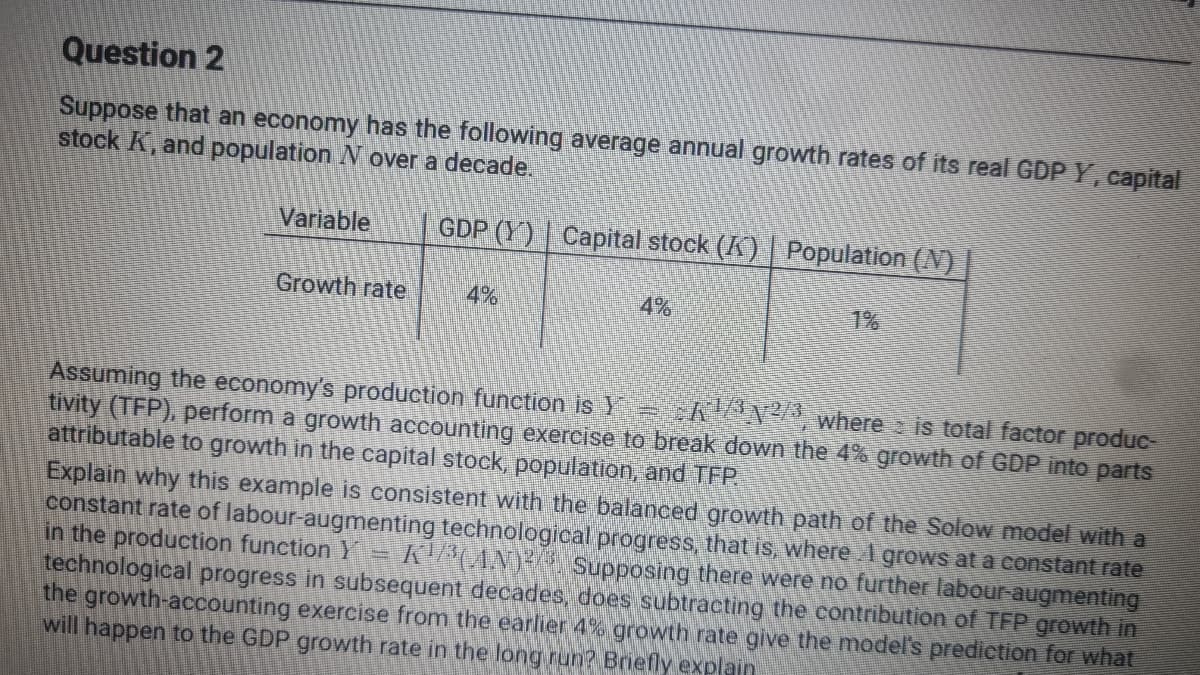Question 2 Suppose that an economy has the following average annual growth rates of its real GDP Y, capital stock K, and population N over a decade. Variable GDP (Y) | Capital stock (K I Do
Question 2 Suppose that an economy has the following average annual growth rates of its real GDP Y, capital stock K, and population N over a decade. Variable GDP (Y) | Capital stock (K I Do
Principles of Economics 2e
2nd Edition
ISBN:9781947172364
Author:Steven A. Greenlaw; David Shapiro
Publisher:Steven A. Greenlaw; David Shapiro
Chapter20: Economic Growth
Section: Chapter Questions
Problem 20RQ: For a high-income economy like the United States, what aggregate production function elements are...
Related questions
Question
Can you help me with this question please. Thank you!
All help is hugely appreciated.

Transcribed Image Text:Question 2
Suppose that an economy has the following average annual growth rates of its real GDP Y, capital
stock K, and population N over a decade.
Variable
GDP (Y) | Capital stock (K) | Population (N)
Growth rate
4%
4%
1%
Assuming the ēconomy's production function is Y AN² where is total factor produc-
tivity (TFP), perform a growth accounting exercise to break down the 4% growth of GDP into parts
attributable to growth in the capital stock, population, and TFP.
Explain why this example is consistent with the balanced growth path of the Solow model with a
constant rate of labour-augmenting technological progress, that is, where A grows at a constant rate
in the production function Y
technological progress in subsequent decades, does subtracting the contribution of TFP growth in
the growth-accounting exercise from the earlier 4% growth rate give the model's prediction for what
will happen to the GDP growth rate in the long run? Briefly explain
K ANY Supposing there were no further labour-augmenting
Expert Solution
This question has been solved!
Explore an expertly crafted, step-by-step solution for a thorough understanding of key concepts.
Step by step
Solved in 2 steps

Knowledge Booster
Learn more about
Need a deep-dive on the concept behind this application? Look no further. Learn more about this topic, economics and related others by exploring similar questions and additional content below.Recommended textbooks for you

Principles of Economics 2e
Economics
ISBN:
9781947172364
Author:
Steven A. Greenlaw; David Shapiro
Publisher:
OpenStax

Essentials of Economics (MindTap Course List)
Economics
ISBN:
9781337091992
Author:
N. Gregory Mankiw
Publisher:
Cengage Learning

Brief Principles of Macroeconomics (MindTap Cours…
Economics
ISBN:
9781337091985
Author:
N. Gregory Mankiw
Publisher:
Cengage Learning

Principles of Economics 2e
Economics
ISBN:
9781947172364
Author:
Steven A. Greenlaw; David Shapiro
Publisher:
OpenStax

Essentials of Economics (MindTap Course List)
Economics
ISBN:
9781337091992
Author:
N. Gregory Mankiw
Publisher:
Cengage Learning

Brief Principles of Macroeconomics (MindTap Cours…
Economics
ISBN:
9781337091985
Author:
N. Gregory Mankiw
Publisher:
Cengage Learning